Biodiversity at the University of Leeds in 2024

Despite our University campus being right on the edge of Leeds city centre, it is bursting with nature.
At the Sustainability Service, we are committed to continuously improving biodiversity across campus, as well as looking for ways to engage our staff and students with nature. Leading this is Mike Howroyd, whose role involves working collaboratively with the estates team, academic staff.
So what have we got coming up to support biodiversity on campus?
Brand new biodiversity plans in 2024
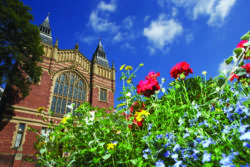
2024 is an exciting year for biodiversity on campus. We're in the process of updating our Biodiversity Standard, which is a key policy that helps guide our efforts to boost biodiversity. The new standard will focus on putting people first, reconnecting with nature, and greening our spaces while meeting the needs of a modern campus.
As part of this we’ll be restructuring our Biodiversity Steering Group. This is the group of representatives from across the University that will direct the University of Leeds’ biodiversity programme. The steering group’s focus will be on improving wildlife, wellbeing and health, and helping people to connect more with nature.
We also have plans to work with the West Yorkshire Combined Authority on the West Yorkshire Local Nature Recovery Strategy. This exciting initiative ensures that our actions go beyond our own campus, creating positive contributions to the broader ecosystem.
There are already lots of ways for staff, students and the local community to get involved in biodiversity initiatives on campus. We run regular biodiversity events and volunteering opportunities, which range from our monthly Wildlife Wanders (led by Staff Sustainability Architect Les Arkless and other passionate colleagues), our Biodiversity Monitoring Programme (led by Student Sustainability Architect Hannah Long), through to litter picks and community gardening events.
Building a biodiversity baseline for campus
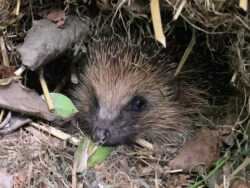
In 2023 we started a comprehensive habitat survey, covering both the main campus and the University farm.
This is the first part of a full estate survey that will create a starting point for understanding the variety of plant and animal life across the University, called a 'biodiversity baseline’. The survey will provide a detailed understanding of the natural environment on our city campus and show where things are going well and what can improve.
The initial survey shows that our campus has 4.46 kilometres of hedgerows, over 5 hectares of grassland, and nearly 1500 trees! While this is fantastic, there’s also 28 hectares (over half of the campus) that’s occupied by roads, footpaths, and buildings. This presents us with room for expanding our natural environment.
A new ‘Living Lab’: making a Digital Twin of the Roger Stevens Pond
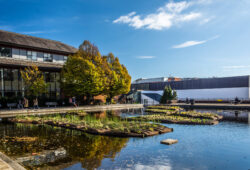
Living Labs are a collaborative approach to finding solutions to real world problems, using campus as a testbed for research, teaching and learning .
Did you know that the floating islands on the Roger Stevens pond were part of a Living Lab research project to remove the need to chemically treat the water? It’s now host to much loved campus wildlife including mallard ducks and a heron.
This year, we’re supporting a new project to create a digital twin of the Roger Stevens Pond. This is a pilot project to create an interactive virtual space using live data from the pond sensors to aid research and learning.
We’ve been working with the tech company ‘Slingshot Simulations to create a platform for presenting this. The platform will allow us to present the data from the pond online in real-time. If this project is successful, there’s the potential to use it in a wider area; perhaps even the whole campus!
Growing our woodland at Gair Wood
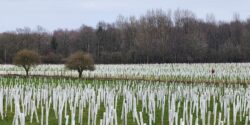
Gair Wood, our 66,000-tree woodland creation project near Golden Acre Park, is entering its second year. This project is another collaborative Living Lab which is being used for research and teaching. The woodland will also boost biodiversity and provide greater public access to green space.
A local 'friends' group has been established to assist in tree maintenance and other activities on site, and plans are underway to open selected footpaths to the public as the site becomes more established.
Tree planting is one of the ways that we can tackle climate change and the biodiversity crisis, and in time Gair Wood will contribute towards the delivering net zero principle of our Climate Plan. It also links to wider tree planting initiatives including the White Rose Forest.
Developing mini meadows on campus
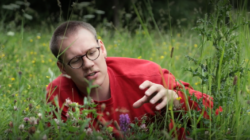
The mini meadows Living Lab project on campus is designed and led by PhD student Seb Stroud (pictured above) and was a recipient of the Queen’s Jubilee Prize. It involves leaving ‘wild’ spots on campus, letting the grass grow long and seeing what flowers come through when nature is allowed to thrive. Three mini meadows have been created on campus. One in St George’s Field, one near Edward Boyle library and one by the LC Miall building.
This year, Seb is poised to publish some early findings on the benefits of the meadows – which includes biodiversity, soil quality and the amount of carbon that gets captured in the soil. This research will help us understand the broader implications of grassland preservation and how this can support climate action.
Peregrine cam on stand by!
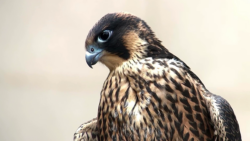
As we eagerly anticipate spring, our famous ‘peregrine cam’ stands ready to - hopefully! - capture a successful nesting period this year.
Peregrines have been seen around Parkinson Tower since 2018. Ten young birds have been raised over the years on a nest in a window alcoves at the top of the tower. One of these young birds, a male ringed with the code ‘TBD’, has been spotted in Bradford. We’re hoping he will go on to raise his own family there!
In 2023 three eggs were laid, but unfortunately they all failed to hatch. Peregrines are a protected species which means removing eggs from the nest is prohibited without a special licence. You might therefore spot the eggs still on the peregrine camera. We’re hoping for a more successful breeding season this year! We have already seen some evidence of the peregrines showing an interest in the nest area, which received some maintenance earlier in the year to ensure it’s ready for them.
To keep up to date with the peregrines, check out @UoLPeregrines and @LeedsBirder on X. Les and Paul regularly post updates and amazing footage of the peregrines on the tower – some of which you can see in our recent ‘Biodiversity at Leeds’ video.
The peregrines, along with our campus heron, rabbits, ducks, foxes, and other wildlife are a reminder of the importance of our collective dedication to preserving and enhancing urban biodiversity.
Getting involved
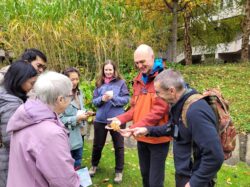
We share updates about biodiversity on campus through our social channels and sustainability newsletter, so make sure you’re signed up and following us!
We also share regular biodiversity activities on our events page. One to look out for this month is an introduction to biodiversity monitoring, led by Student Sustainability Architect Hannah Long. The session takes place on Thursday 15 January and you can sign up here. It includes an introduction to tools you can use to recognise different plants and animals on campus. The session will allow you to contribute to our biodiversity monitoring programme that helps us to better manage campus biodiversity.
We hope you’ll join us in creating a greener, more sustainable future for campus and beyond.
Keep up to date on the latest news
-
- Follow us on Twitter: @UoL_Sus
- Follow us on Instagram: @uol_sus
- Follow us on Facebook: @UoLSustainability
- Sign up to our Sustainability newsletter
United Nations Sustainable Development Goals
 We use the United Nations Sustainable Development Goals (SDGs) as a framework to guide our activity. Our work on Student Citizenship links to all of the SDGs.
We use the United Nations Sustainable Development Goals (SDGs) as a framework to guide our activity. Our work on Student Citizenship links to all of the SDGs.
Find out more about our impact on the SDGs.
